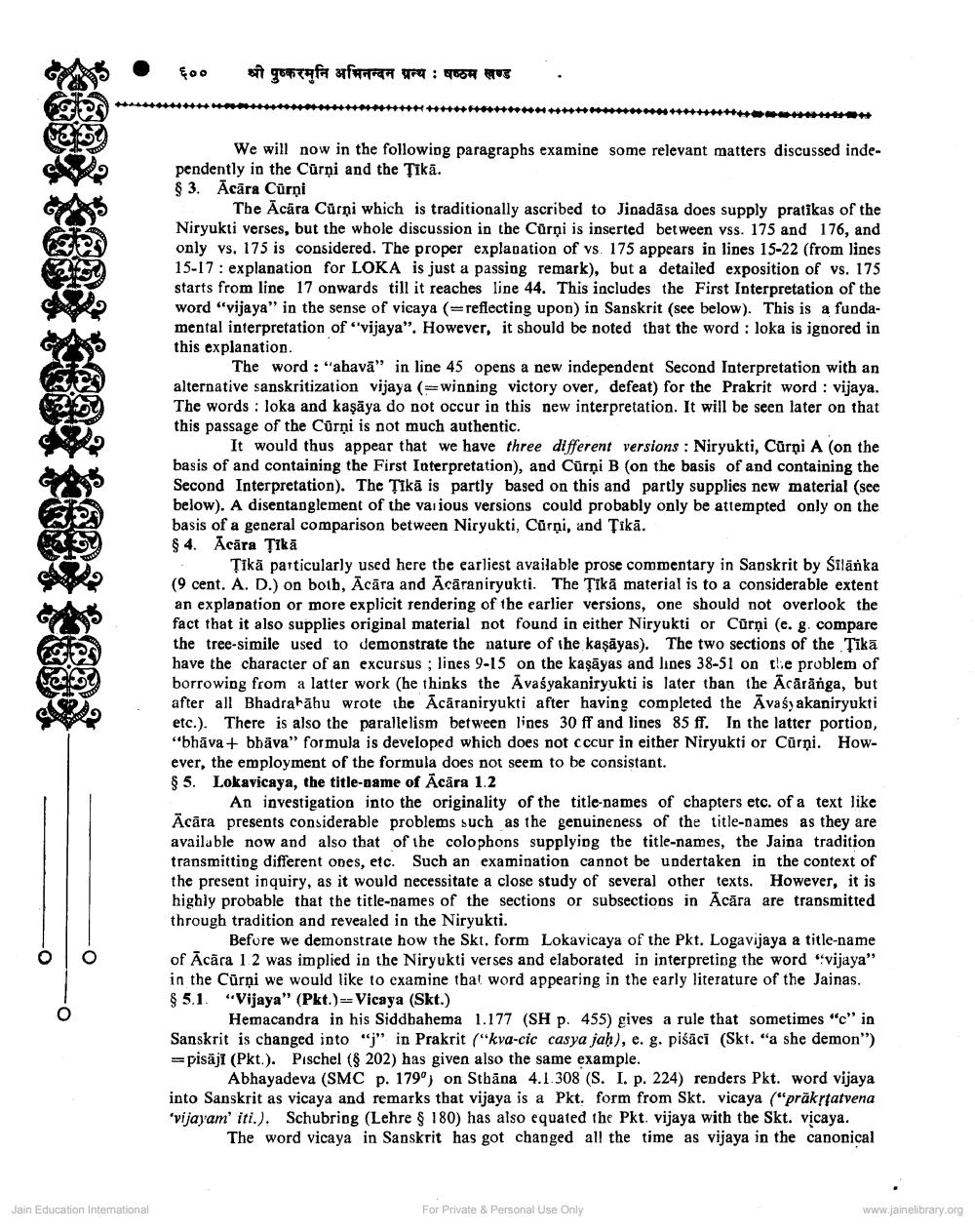Book Title: Logavijaya Niksepa and Lokavicaya Author(s): Bhatt Publisher: Z_Pushkarmuni_Abhinandan_Granth_012012.pdf View full book textPage 5
________________ ६०० श्री पुष्करमुनि अभिनन्दन अन्य : षष्ठम खण्ड We will now in the following paragraphs examine some relevant matters discussed independently in the Cūrni and the Țikā. § 3. Ācāra Cūrni The Ācāra Cürni which is traditionally ascribed to Jinadasa does supply pratikas of the Niryukti verses, but the whole discussion in the Curņi is inserted between yss. 175 and 176, and only vs. 175 is considered. The proper explanation of vs. 175 appears in lines 15-22 (from lines 15-17: explanation for LOKA is just a passing remark), but a detailed exposition of vs. 175 starts from line 17 onwards till it reaches line 44. This includes the First Interpretation of the word "vijaya" in the sense of vicaya ( reflecting upon) in Sanskrit (see below). This is a fundamental interpretation of vijaya". However, it should be noted that the word : loka is ignored in this explanation. The word : "ahavā" in line 45 opens a new independent Second Interpretation with an alternative sanskritization vijaya (=winning victory over, defeat) for the Prakrit word : vijaya. The words : loka and kaşāya do not occur in this new interpretation. It will be seen later on that this passage of the Cūrņi is not much authentic. It would thus appear that we have three different versions : Niryukti, Cürni A (on the basis of and containing the First Interpretation), and Curņi B (on the basis of and containing the Second Interpretation). The Tikā is partly based on this and partly supplies new material (see below). A disentanglement of the various versions could probably only be attempted only on the basis of a general comparison between Niryukti, Cūrņi, and Tikā. $ 4. Ācāra Țikā Tikā particularly used here the earliest available prose commentary in Sanskrit by Silanka (9 cent. A. D.) on both, Ācāra and Ācāraniryukti. The Tikā material is to a considerable extent an explanation or more explicit rendering of the earlier versions, one should not overlook the fact that it also supplies original material not found in either Niryukti or Cūrņi (e. g. compare the tree-simile used to demonstrate the nature of the kaşāyas). The two sections of the Tikā have the character of an excursus ; lines 9-15 on the kaşāyas and lines 38-51 on the problem of borrowing from a latter work (he thinks the Avaśyakaniryukti is later than the Acaränga, but after all Bhadrahāhu wrote the Ācārapiryukti after having completed the Āvasy akaniryukti etc.). There is also the parallelism between lines 30 ff and lines 85 ff. In the latter portion, "bhāva+ bhāva" formula is developed which does not cccur in either Niryukti or Cūrņi. However, the employment of the formula does not seem to be consistant. $ 5. Lokavicaya, the title-Dame of Ācāra 1.2 An investigation into the originality of the title-names of chapters etc. of a text like Acāra presents considerable problems such as the genuineness of the title-names as they are available now and also that of the colophons supplying the title-names, the Jaina tradition transmitting different ones, etc. Such an examination cannot be undertaken in the context of the present inquiry, as it would necessitate a close study of several other texts. However, it is highly probable that the title-names of the sections or subsections in Acāra are transmitted through tradition and revealed in the Niryukti. Before we demonstrate how the Skt. form Lokavicaya of the Pkt. Logavijaya a title-name of Ācāra 1 2 was implied in the Niryukti verses and elaborated in interpreting the word "vijaya" in the Cūrņi we would like to examine that word appearing in the early literature of the Jainas. $ 5.1. “Vijaya" (Pkt.) --Vicaya (Skt.) Hemacandra in his Siddhahema 1.177 (SH p. 455) gives a rule that sometimes "c" in Sanskrit is changed into "j" in Prakrit ("kva-cic casya jah), e. g. piśāci (Skt. "a she demon") =pisäji (Pkt.). Pischel (8202) has given also the same example. Abhayadeva (SMC p. 179°) on Stbāna 4.1.308 (S. I. p. 224) renders Pkt. word vijaya into Sanskrit as vicaya and remarks that vijaya is a Pkt. form from Skt. vicaya ("prākrtatvena 'vijayam' iti.). Schubring (Lehre $ 180) has also equated the Pkt. vijaya with the Skt. vicaya. The word vicaya in Sanskrit has got changed all the time as vijaya in the canonical Jain Education International For Private & Personal Use Only www.jainelibrary.orgPage Navigation
1 ... 3 4 5 6 7 8 9 10
